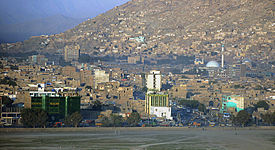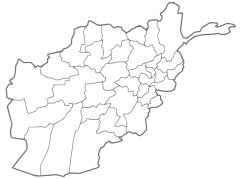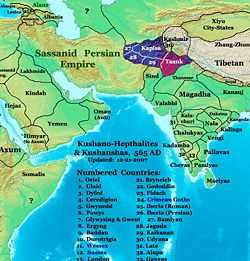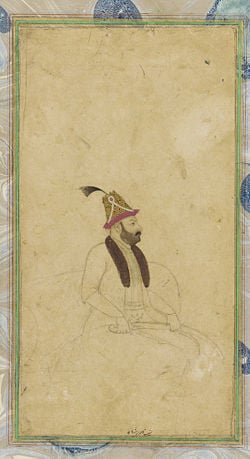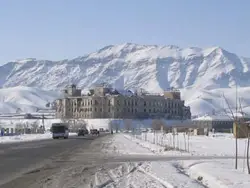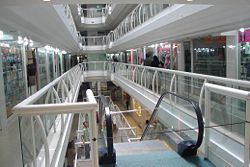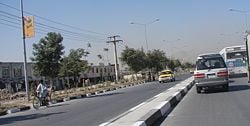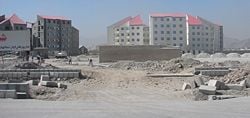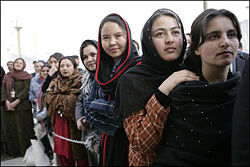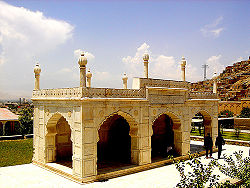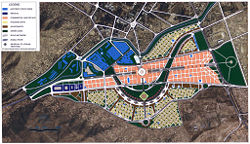Kabul
| Kabul کابل Caubul, Cabul, Cabool | |
|---|---|
| Kabul City | |
| Province | Kabul |
| Coordinates | |
| Population - Metro Area (2011) |
3,071,400 |
| City Districts | 18 sectors or boroughs |
| Area - Elevation |
425 km² (164 sq mi) 1,790 m (5,873 ft) |
| Time zone | UTC+4:30 Kabul |
| Mayor | Muhammad Yunus Nawandish |
Kābul (Persian: کابل, IPA: [kɑː'bʊl]) is the capital and largest city of Afghanistan, as well as an economic and cultural center. The city is situated 5,900 feet (1,800 m) above sea level in a narrow valley, between two steep ranges of the Hindu Kush mountains along the Kabul River.
Many empires have fought over the city during its 3,500 year history. It offers a strategic location along the trade routes of Southern and Central Asia. Kabul holds a commanding position of the mountain passes from both the north and the south, as well as the main approaches through the Khyber Pass from Pakistan and India. Over the centuries of Kabul's history, invaders included the Persian Empire, Alexander the Great, Muslim Arabs, Turkic peoples, the Mongols, the British Empire, and the Soviet Union.
The economy improved significantly after the fall of the Taliban regime in 2001. Crime, corruption, government capacity, and the rebuilding of war-torn infrastructure pose surmountable challenges. Foreign aid has enabled reconstruction, and the City of Light Development is one of many extensive plans for Kabul's redevelopment.
Despite the devastation of war, there are sights worth seeing in Kabul. They include the Bala Hissar fifth century fort, the 20-feet high Walls of Kabul, and the Mausoleum of Emperor Babur.
Geography
Kabul is situated 5,900 feet (1800 meters) above sea level in a narrow valley, between the two steep Asmai and Sherdawaza mountain ranges along the Kabul River.
The Kabul River, that rises in the Sanglakh Range in Afghanistan, is little more than a trickle for most of the year, but swells in summer due to melting snows.
Kabul has a semi-arid climate with precipitation concentrated in the winter in the form of snow and spring months. The average maximum daytime temperature in January is 39.2°F (4°C), rising to an average maximum of around 89.6°F (32°C) in June. Summers run from June to September and are moderate, with very low humidity. Winters are harsh, snowy and long, lasting from December to March. Spring in Kabul starts in late March and is the wettest part of the year. Mean annual precipitation is 15 inches (384mm).
Environmental issues involve household and medical waste being discarded on streets. Human waste was contained in open sewers, which flowed into the Kabul River and contaminated the city’s drinking water. Urban dump sites are used instead of managed landfills.
In late 2007, the government announced that all the residential houses situated on mountains would be removed so that the hills could be replanted in trees. The plan was to make the city greener and provide residents with more suitable housing.
History
The city of Kabul is thought to have been established between 2000 B.C.E. and 1500 B.C.E.[1] It is mentioned in the Rig Veda, a collection of Indian sacred hymns, (composed between 1700–1100 B.C.E.) and Ptolemy, the Alexandrian astronomer, geographer, and mathematician, referred to it in the second century C.E. The city has a strategic location, commanding the passes from the north and the south, as well as the main approaches through the Khyber Pass to Pakistan and India.
Hellenistic control
Alexander the Great (356–323 B.C.E.) conquered Kabul during his conquest of the Persian Empire. The city later became part of the Seleucid Empire (312-63 B.C.E.) before becoming part of the Mauryan Empire (322–185 B.C.E.).
The Greco-Bactrian Kingdom captured Kabul from the Mauryans in the early second century B.C.E., then lost the city to their subordinates in the Indo-Greek Kingdom in the mid second century B.C.E. Indo-Scythians expelled the Indo-Greeks by the mid first century B.C.E., but lost the city to the Kushan Empire nearly 100 years later.
Kushan Emperor Kujula Kadphises (reigned 30-80 C.E.) conquered Kabul in the early first century and the city remained Kushan territory until the third century C.E.[2][3]
Around 230 C.E., Sassanid vassals known as the Kushanshas replaced the Kushans. In 420 C.E., a Chionites tribe known as the Kidarites took control, who were replaced in the 460s by the Hephthalites, who in turn were defeated in 565 C.E. by a coalition of Persian and Turkish armies.
Kabul became part of the Kushano-Hephthalite Kingdom of Kapisa, who were known as Kabul-Shahan. The rulers of Kabul-Shahan built a huge defensive wall around the city which has survived. Around 670 C.E., the Hindu-Shahi dynasty took control.
Islamic conquest
In 674, Islamic invaders occupied Kabul, although it was not until the ninth century when Ya'qub bin Laith as-Saffar (840-879), a coppersmith turned ruler, established Islam in Kabulistan. Over the remaining centuries to come the city was successively controlled by the Samanids, Ghaznavids, Ghorids, Timurids, Mughols, Durranis, and finally by the Barakzais.
In the thirteenth century the Mongol horde passed through. In the fourteenth century, Kabul rose again as a trading center under the kingdom of Timur-Lung (Tamerlane), who married the sister of Kabul's ruler at the time. But as Timurid power waned, the city was captured in 1504 by Babur and made into his headquarters.
Pashtun rule
Nadir Shah (1698–1747) of Persia captured the city in 1738 but was assassinated nine years later. Ahmad Shah Durrani, an Afghan military commander and personal bodyguard of Nadir, took the throne in 1747, asserted Pashtun rule, and expanded his new Afghan Empire. His son Timur Shah Durrani, transferred the capital of Afghanistan from Kandahar to Kabul in 1776. Timur Shah died in 1793 and was succeeded by his son Zaman Shah Durrani.
British control
In 1826, the kingdom was claimed by Dost Mohammed (1793-1863) and taken from him by the British Indian Army in 1839, who installed the unpopular puppet Shah Shuja (1785–1842). An 1841 local uprising resulted in the loss of the British mission and the subsequent Massacre of Elphinstone's army of approximately 16,000 people, which included civilians and camp followers on their retreat from Kabul to Jalalabad. In 1842, the British returned, plundering Bala Hissar in revenge before retreating to India. Dost Mohammed returned to the throne.
The British invaded in 1878 as Kabul was under Sher Ali Khan's rule, but the British residents were again massacred. The British returned in 1879 under General Roberts, partially destroying Bala Hissar before retreating to India. Amir Abdur Rahman was left in control.
King of Afghanistan
In the early twentieth century, King Amanullah Khan (1892–1960) rose to power. He installed electricity and provided schooling for girls. He drove a Rolls-Royce, and lived in the famous Darul Aman Palace. In 1919, after the Third Anglo-Afghan War, Amanullah announced Afghanistan's independence from foreign interventions. In 1929, Ammanullah Khan left Kabul because of a local uprising and his brother Nader Khan took control. King Nader Khan was assassinated in 1933 and his 19-year-old son, Zahir Shah (1914–2007)), became the King of Afghanistan.
Kabul University opened for classes in early 1930s, and in 1940s, the city began to grow as an industrial center. The streets of the city began being paved in the 1950s.
In the 1960s, the first Marks and Spencer store in Central Asia was built in Kabul. Kabul Zoo was inaugurated in 1967, which was maintained with the help of visiting German Zoologists.
In 1969, a religious uprising at the Pul-e Khishti Mosque protested the Soviet Union's increasing influence over Afghan politics and religion. This protest ended in the arrest of many of its organizers including Mawlana Faizani (b. 1923), a popular Islamic scholar.
In July 1973, Zahir Shah was ousted in a bloodless coup and Kabul became the capital of a republic under Mohammad Daoud Khan (1909–1978), the new president. In 1975, an east-west electric trolleybus system, built with help from Czechoslovakia, was opened in Kabul.
Soviet invasion
The Soviet Union invaded Afghanistan, on December 24, 1979. The Red Army occupied the capital, and turned the city into their command center during the ten-year conflict between the Soviet-allied government and the Mujahideen rebels.
The American Embassy in Kabul closed on January 30, 1989. The city fell into the hands of local militias after the 1992 collapse of Mohammad Najibullah's (1947-1996) pro-communist government. As these forces divided into warring factions, the city increasingly suffered.
By 1993, electricity and water in the city was out. At this time, Burhannudin Rabbani's (b. 1940) militia (Jamiat-e Islami) held power but the nominal prime minister Gulbuddin Hekmatyar's (b. 1947) Hezb-e Islami began shelling the city, which lasted until 1996. Kabul was factionalized, and fighting continued between Jamiat-e Islami, Abdul Rashid Dostum and the Hezbi Wahdat. Tens of thousands of civilians were killed and many more fled as refugees. The United Nations estimated that about 90 percent of the buildings in Kabul were destroyed during these years.
Kabul was captured by the Taliban in September 1996, publicly lynching ex-President Najibullah and his brother. During this time, all the fighting between different militias came to an end.
U.S. invasion
In October 2001, the United States invaded Afghanistan. The Taliban abandoned Kabul because of extensive American bombing, while the Afghan Northern Alliance (former mujahideen or millias) came to retake the city. On December 20, 2001, Kabul became the capital of the Afghan Transitional Administration, which transformed to the present government of Afghanistan that is led by US-backed President Hamid Karzai (b. 1957).
Government
Afghanistan is an Islamic republic in which the president, who is both the chief of state and head of government, is elected, with two vice presidents, by direct vote for a five-year term, and is eligible for a second term. The bicameral National Assembly consists of the Wolesi Jirga (House of People) of no more than 249 members, who are directly elected for five-year terms, and the Meshrano Jirga (House of Elders), of 102 members, with one third elected from provincial councils, another third from local district councils, and the remainder nominated by the president.
Despite gains toward building a stable central government, a resurgent Taliban and continuing provincial instability - particularly in the south and the east - remain serious challenges for the Afghan Government.
Kabul city is one of the 15 districts of Kabul Province, and is divided into 18 sectors, each of which covers several neighborhoods.
Unlike other cities, Kabul City has two independent councils or administrations operating simultaneously: the prefecture and the municipality. The prefect who is also the governor of Kabul province, is appointed by the Ministry of Interior, and is responsible for the administrative and formal issues of the entire province. The mayor of Kabul city is selected by the President of Afghanistan, and is responsible for the city's planning and environmental work.
The police and security forces belong to the prefecture and Ministry of Interior. The Chief of Police is selected by the Minister of Interior and is responsible for law enforcement and security of the city.
Economy
Afghanistan's economy in 2008 was recovering from decades of conflict, and had improved significantly since the fall of the Taliban regime in 2001 largely because of the infusion of international aid, the recovery of the agricultural sector, and service sector growth.
Despite this progress, Afghanistan is extremely poor, landlocked, and highly dependent on foreign aid. Criminality, insecurity, and the Afghan Government's inability to extend rule of law to all parts of the country pose challenges to future economic growth.
Expanding poppy cultivation and a growing opium trade generate roughly $4-billion in illicit economic activity and looms as one of Kabul's most serious policy concerns. Other long-term challenges include: budget sustainability, job creation, corruption, government capacity, and rebuilding war-torn infrastructure.
Per capita GDP was estimated at $1000 in 2007.
As of October 2007, there are approximately 16 licensed banks in Kabul: including Da Afghanistan Bank, Afghanistan International Bank, Standard Chartered Bank, Kabul Bank, Azizi Bank, Punjab National Bank, Habib Bank and others. Western Union offices are also found in many locations throughout the city.
A small indoor shopping mall (Kabul City Center) with a four-star (Safi Landmark) hotel on the top six floors opened in 2005. A five-star Serena Hotel also opened in 2005. Another five-star Marriott Hotel was under construction. The landmark InterContinental Hotel has been refurbished and was in operation.
Kabul's main products include munitions, cloth, furniture and beet sugar, but, since 1978, a state of nearly continuous war has limited economic productivity.
Afghanistan has 47.53 billion cubic meters of proven natural gas reserves, nearly twice that of India.
About 4 miles (6 km) from downtown Kabul, in Bagrami, a 22-acre (9 ha) wide industrial complex has been completed.
A 25-year project called the City of Light Development has been proposed for multi-function commercial, historic and cultural development within the Old City of Kabul along the southern side of the Kabul River.
Kabul is linked with Ghazni, Kandahar, Herat and Mazar-e Sharif via a long beltway (circular highway) that stretches across the country. Highways link Kabul with Pakistan to the east and Tajikistan to the north. Kabul has a fleet of approximately 800 Millie Buses. Modern electric buses were to be reintroduced. There are yellow taxicabs that can be spotted just about anywhere. With the exception of motorcycles many vehicles in the city operate on LPG. Kabul International Airport is the base for Ariana Afghan Airlines, Afghanistan's national carrier.
Demographics
Kabul had a population of 2,994,000 in 2005. Persian-speakers form the majority of the city's population, with the predominately Sunnite Tajiks being the largest group, followed by Shi'ite Hazaras.
Pashto-speakers, also Sunnites, form the most important minority, followed by the Turkic-speaking Uzbeks. There are also sizable numbers of Aimak, Baloch, Pashai, as well as Sikhs and Hindus.
The city hosts a We Are the Future center, a child care center which is managed under the direction of the mayor’s office and the international NGO Glocal Forum. The goal of Glocal Forum is to mobilize global resources for the benefit of children in conflict and post-conflict cities through the creation of We Are the Future Child Centers with youth-led activities. The program was launched in 2004 as a strategic partnership between the Glocal Forum and the Quincy Jones' Listen Up Foundation. It has the support of a broad coalition including the World Bank and major private companies.[4]
Universities in Kabul include: Kabul University, Kabul Polytechnic, American University of Afghanistan, National Military Academy of Afghanistan, University of Afghanistan, Kabul Medical University, and the International School of Kabul.
Places of Interest
The old part of Kabul is filled with bazaars nestled along its narrow, crooked streets. Tappe-i-Maranjan is a nearby hill where Buddhist statues and Graeco-Bactrian coins from the second century B.C.E. have been found. Paghman and Jalalabad are interesting valleys north and east of the city. Other places of interest include Kabul City Center shopping mall, the shops around Flower Street and Chicken Street, Wazir Akbar Khan district, Babur Gardens, Kabul Golf Club, Kabul Zoo, Shah Do Shamshera and other famous Mosques, the Afghan National Gallery, Afghan National Archive, Afghan Royal Family Mausoleum, the OMAR Mine Museum, Bibi Mahroo Hill, Kabul Cemetery, and Paghman Gardens. Other sites of interest include:
- Bala Hissar, an ancient fortress located in Kabul, dating from the fifth century C.E. The British destroyed the fort in 1879 in retaliation for the death of their envoy. It has been restored as a military college.
- The Walls of Kabul, which are a staggering 20 feet (6.1 meters) high and 12 feet (3.7 meters) thick, which start at the fortress and follow the mountain ridge in a sweeping curve down to the river.
- The Mausoleum of Emperor Babur, a Muslim conqueror from Central Asia who laid the basis for the Mughal dynasty of India. The mausoleum dates from 1530.
- The Afghan National Museum, which displays an impressive statue of Surya excavated at Khair Khana.
- The ruined Darul Aman Palace, built during the 1920s as a part of the reformist King Amanullah Khan's modernization drive.
- The Minar-i-Istiqlal (Column of Independence) built in 1919 after the Third Afghan War.
- The mausoleum of Timur Shah Durrani, built after 1793.
- The imposing Id Gah Mosque, built in 1893, which is the second largest mosque in Kabul, where two million people journey offer Eid prayers twice a year.
- The Minaret of Chakari, destroyed in 1998, which had Buddhist swastika and both Mahayana and Theravada qualities.
Looking to the future
Criminality, insecurity, and the Afghan Government's inability to extend rule of law to all parts of the country pose challenges to future economic growth. Other long-term challenges include: budget sustainability, job creation, corruption, government capacity, and rebuilding war-torn infrastructure. In the absence of other economic opportunities, expanding poppy cultivation and a growing opium trade generate roughly $4-billion in illicit economic activity.
Foreign aid has enabled reconstruction, and the City of Light Development is one extensive plan for Kabul's redevelopment. Issues surrounding waste disposal and contaminated [[drinking water[[ indicated the basic steps required to improve the city.
Notes
- ↑ The history of Afghanistan.Gandhara.com. Retrieved December 5, 2008.
- ↑ John E. Hill, (translator), September 2003. The Western Regions according to the Hou Hanshu University of Washington - Walter Chapin Simpson Center for the Humanities. Retrieved December 5, 2008.
- ↑ John E. Hill, (translator), September 2004. The Peoples of the West from the Weilue, 魏略 by Yu Huan, 魚豢: A Third Century Chinese Account Composed between 239 and 265 C.E. University of Washington - Walter Chapin Simpson Center for the Humanities. Retrieved December 5, 2008.
- ↑ The Glocal Forum. We Are the Future Retrieved December 5, 2008.
ReferencesISBN links support NWE through referral fees
- Brooks, D. 2001. "Kabul." LITERARY REVIEW -MADISON-. 45: 143-149. OCLC 192468747
- Ghubār, Ghulām Muḥammad, and Sherief A. Fayez. 2001. Afghanistan in the Course of History. Herndon, VA: All Prints. ISBN 0970796404.
- Griffiths, John Charles. 2001. Afghanistan: A History of Conflict. London: Carlton Books. ISBN 1842225979
- Hou Hanshu 88, Second Ed. Translated by John E. Hill, [1]. Extensively revised with additional notes and appendices.
- Hosseini, Khaled. 2003. The Kite runner. New York: Riverhead Books. ISBN 9781573222457
- Jones, Ann. 2006. Kabul in winter: life without peace in Afghanistan. New York: Metropolitan. ISBN 9780805078848
- Rashid, Ahmed. 2002. Taliban: Islam, Oil and the New Great Game in Central Asia. New York: I.B. Tauris. ISBN 1860648304
- Tang, D. 2008. "Kabul notebook." SPECTATOR -LONDON- WEEKLY- (9401): 26-27. OCLC 276070263
- Toynbee, Arnold Joseph. 1961. Between Oxus and Jumna. New York: Oxford University Press. ISBN 0192152262
- "WORLD: AFGHANISTAN - School in Kabul The fight to educate girls." 2008. TIME 40. OCLC 236849076
- World Fact Book. 2008. Afghanistan Retrieved December 2, 2008.
External links
All links retrieved May 27, 2014.
Credits
New World Encyclopedia writers and editors rewrote and completed the Wikipedia article in accordance with New World Encyclopedia standards. This article abides by terms of the Creative Commons CC-by-sa 3.0 License (CC-by-sa), which may be used and disseminated with proper attribution. Credit is due under the terms of this license that can reference both the New World Encyclopedia contributors and the selfless volunteer contributors of the Wikimedia Foundation. To cite this article click here for a list of acceptable citing formats.The history of earlier contributions by wikipedians is accessible to researchers here:
The history of this article since it was imported to New World Encyclopedia:
Note: Some restrictions may apply to use of individual images which are separately licensed.
